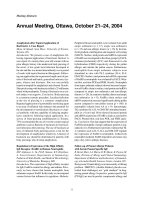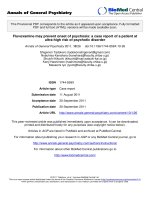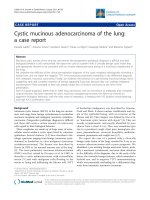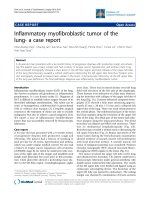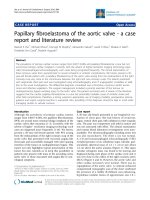Báo cáo y học: " Eosinophilic pneumonia associated with bleomycin in a patient with mediastinal seminoma: a case report" pot
Bạn đang xem bản rút gọn của tài liệu. Xem và tải ngay bản đầy đủ của tài liệu tại đây (734.65 KB, 4 trang )
JOURNAL OF MEDICAL
CASE REPORTS
Hapani et al. Journal of Medical Case Reports 2010, 4:126
/>Open Access
CASE REPORT
BioMed Central
© 2010 Hapani et al; licensee BioMed Central Ltd. This is an Open Access article distributed under the terms of the Creative Commons
Attribution License ( which permits unrestricted use, distribution, and reproduction in
any medium, provided the original work is properly cited.
Case report
Eosinophilic pneumonia associated with
bleomycin in a patient with mediastinal seminoma:
a case report
Sanjaykumar Hapani, David Chu and Shenhong Wu*
Abstract
Introduction: Lung toxicities resulting from the chemotherapeutic agent bleomycin encompass a variety of
pathological changes, including bronchiolitis obliterans organizing pneumonia, interstitial pneumonitis and
progressive interstitial fibrosis. We report a rare case of eosinophilic pneumonia associated with bleomycin.
Case presentation: A 44-year-old Hispanic man with a primary mediastinal seminoma complicated by superior vena
cava syndrome underwent treatment with four cycles of bleomycin, etoposide and cisplatin. He had a complete
positive response to the chemotherapy. However, three months after treatment he presented with shortness of breath
and severe hypoxemia associated with peripheral eosinophilia. Computed tomography showed bilateral diffuse
interstitial infiltrates that were refractory to antibiotic treatment. A lung biopsy showed eosinophilic pneumonia. He
was subsequently treated with high-dose prednisone, resulting in a complete resolution of his symptoms and lung
infiltrates.
Conclusion: This case illustrates that eosinophilic pneumonia may be a late sequela of bleomycin toxicity, and may
respond dramatically to steroid treatment.
Introduction
Bleomycin is an antineoplastic agent derived from Strep-
tomyces verticillus, and is widely used in the treatment of
testicular carcinoma, Hodgkin's and non-Hodgkin's lym-
phoma as well as squamous cell carcinomas of the head
and neck. However it has well-known pulmonary toxici-
ties, including diffuse alveolar damage, bronchiolitis
obliterans organizing pneumonia (BOOP), interstitial
pneumonitis, and progressive interstitial fibrosis [1]. This
report illustrates a rare case of severe bleomycin-associ-
ated eosinophilic pneumonia (EP) that responded to ste-
roid treatment.
Case presentation
A 44-year-old Hispanic man was diagnosed in October
2006 with a primary mediastinal seminoma complicated
by superior vena cava (SVC) syndrome. He was started
on a first-line systemic therapy of bleomycin, etoposide
and cisplatin (BEP). Bleomycin (30 units) was adminis-
tered on days 2, 9 and 16; etoposide (100 mg/m
2
intrave-
nously) on days 1 to 5; and cisplatin (20 mg/m
2
intravenously) on days 1 to 5 every three weeks for a total
of four cycles. The total cumulative bleomycin dosage
was 360 units with the last dose of bleomycin adminis-
tered on 29 December 2006. Following chemotherapy, the
patient achieved a complete response to treatment with
resolution of the SVC syndrome. His anterior mediastinal
mass decreased substantially in size, with a complete nor-
malization of the standardized uptake value (SUV) by
computed tomography (CT) and positron emission
tomography (PET); his beta human chorionic gonadotro-
pin (β-HCG) level decreased from 5452 to an undetect-
able level; and his alpha fetoprotein (AFP) level remained
within the normal range. He tolerated the chemotherapy
without any adverse side effects.
Three months after the treatment, he presented at the
emergency department at Stony Brook University Medi-
cal Center, having suffered from progressive shortness of
breath for three days but without any other obvious pre-
cipitating factors. He was not on any medication and he
* Correspondence:
1
Division of Medical Oncology, Department of Medicine, Stony Brook
University, Stony Brook, New York, USA
Full list of author information is available at the end of the article
Hapani et al. Journal of Medical Case Reports 2010, 4:126
/>Page 2 of 4
did not have any gastrointestinal symptoms. Physical
examination revealed tachycardia, tachypnea, hypoxia
and decreased breath sounds with fine crackles bilater-
ally. Chest X-ray showed a right lower lobe infiltrate.
Interestingly, his eosinophil count had increased from a
baseline level of 2% to 10%, although his total white blood
cell count was within the normal range. Subsequent CT
of his chest showed extensive patchy ground-glass opaci-
ties in the right upper lobe, middle lobe and left lung
without evidence of any pulmonary embolism (Figure
1A). He was treated with ceftriaxone and azithromycin
empirically for community acquired pneumonia. Because
he did not respond to a four-day course of the antibiotic
treatment and showed worsening dyspnea, our patient
was admitted to the medical intensive care unit, and
underwent a thoracoscopic right middle lobe wedge
biopsy to investigate possible bleomycin-induced lung
toxicity. Pathological examination of the lung tissue
revealed severe widespread organizing pneumonia with
accompanying eosinophil-rich inflammatory infiltrates
(Figure 2). Cultures and stains of the tissue showed nega-
tive for any infectious agents including Mycobacterium
tuberculosis, viral, fungal or Pneumocystis jirovecii infec-
tion. There was also no evidence of seminoma recur-
rence.
Our patient was started on oral prednisone 70 mg daily,
and his respiratory status slowly improved over the next
few days. Treatment continued with a high-dose predni-
sone for one month. A follow-up CT of his chest revealed
a complete resolution of the bilateral ground-glass opaci-
ties (Figure 1B). Furthermore, his peripheral eosinophilia
level decreased from 10% to <2%. The prednisone was
then tapered off over a period of three months. Our
patient has remained symptom-free and disease-free for
two years.
Discussion
The association between bleomycin and EP has not been
well established. Only three cases of bleomycin-induced
EP with a self-limiting clinical course have been
described in the literature so far [2]. Our patient demon-
strates a severe case of EP associated with the use of bleo-
mycin that responded well to steroid treatment.
Bleomycin-induced lung injury occurs in 3-5% of
patients treated with the drug, but fatal effects are rare
[3,4]. Patients who suffer from lung and skin toxicities
may be deficient in a bleomycin hydrolase enzyme [5].
Risk factors for bleomycin toxicity include older age, ciga-
rette smoking, prior radiotherapy, oxygen therapy, a
cumulative dose of bleomycin greater than 450U, an
intravenous route of administration of the drug, and an
Figure 1 Pulmonary infiltrates before and after steroid treat-
ment. (A) Computed tomography (CT) of chest with intravenous con-
trast in March 2007 showing right upper lobe, right middle lobe and
left lung with patchy ground-glass opacities. (B) CT of chest one month
after steroid treatment showing complete resolution of ground-glass
opacities in both lung fields.
A
B
Figure 2 Histology of pulmonary lesions. Hematoxylin and eosin
stain was used for the lung biopsy, original magnification, 400×. Arrow
points to eosinophils with pink color; alveoli are infiltrated with inflam-
matory cells, mainly eosinophils, lymphocytes and neutrophils. There is
no evidence of vasculitis or alveolar hemorrhage. There is some fibrous
tissue in the periphery. Note that only distal airways are involved with
sparing of proximal airways.
Hapani et al. Journal of Medical Case Reports 2010, 4:126
/>Page 3 of 4
underlying or worsening renal insufficiency [6-10]. There
are several known pulmonary-related adverse effects of
bleomycin including diffuse alveolar damage, pneumoni-
tis, BOOP and pulmonary fibrosis. However, none of
these changes are pathognomonic of bleomycin toxicity.
The relationship between EP and bleomycin has been
suggested by others in earlier case studies. Yousem et al.
described three cases of bleomycin-associated EP with
few symptoms and a self-limiting clinical course, for
which corticosteroids were not used to treat the condi-
tion [2]. Holoye et al. described three cases of bleomycin-
associated hypersensitivity pneumonitis with patchy
eosinophilic infiltrates that fitted the spectrum of EP [11].
Eosinophilic pneumonia is an inflammatory, reactive
pulmonary process with multiple etiologies including sys-
temic diseases such as Churg-Strauss disease, and para-
sitic diseases. It can also be caused by a variety of drugs
including antibiotics, non-steroidal anti-inflammatory
drugs (NSAIDs), anti-convulsants, anti-depressants,
angiotensin converting enzyme inhibitors, inhaled toxins
such as cigarette smoke, and chemotherapy [12]. Drug-
induced EP may be considered as a possible hypersensi-
tivity reaction. Afflicted patients may complain of a wide
range of symptoms ranging from flu-like symptoms to
shortness of breath, cough, weight loss and fever. The dis-
ease can manifest itself as early as days to some weeks
after exposure to the inciting etiology, or as a late sequela
a few months later. Our patient developed respiratory
symptoms three months after completing the bleomycin
treatment, suggesting a late sequela.
A definitive diagnosis of EP is made when there is evi-
dence of a parenchymal patchy infiltrate on a chest X-ray,
peripheral blood eosinophilia, and increased eosinophils
in either lung biopsy tissue or bronchoalveolar lavage
(BAL) fluid (usually >25%) [12]. A BAL or lung biopsy can
be undertaken, depending on the location of the ground-
glass opacity and its accessibility. Histological examina-
tion of the lung tissue should reveal an accumulation of
eosinophils and macrophages in the alveoli; the alveolar
septa are thickened and infiltrated by eosinophils, lym-
phocytes and macrophages [13]. CT may be helpful as a
'road map' for a potential biopsy or to give a better view of
the location of the opacities, but it is not necessary to
confirm a diagnosis.
The toxicity related to bleomycin is two-fold. The pri-
mary event is thought to be an injury to the endothelial
cells leading to fluid leakage and pulmonary hemorrhage.
Subsequently it causes direct toxicity to type 1 pneumo-
cytes which can lead to death, and secondary hyperplasia
of type 2 pneumocytes [9].
There is no proven effective treatment for bleomycin-
induced pneumonitis, although corticosteroids are widely
used [5]. For patients with asymptomatic EP, it could be a
self-limiting condition, and close observation may be a
sufficient treatment, as shown by Yousem et al. [2]. How-
ever, steroids remain the core treatment of EP. In our case
of severe bleomycin-associated EP, high-dose prednisone
therapy led to the rapid resolution of the respiratory
symptoms as well as of the radiographic abnormalities. It
is thought that corticosteroids induce healing by apopto-
sis of the eosinophils [12]. Our case therefore suggests
that there is a role for steroids in the treatment of bleo-
mycin-associated EP.
Conclusion
We have presented a case of severe EP associated with the
use of bleomycin. It manifested as a late sequela of the
bleomycin treatment and responded to high-dose steroid
treatment. Eosinophilic pneumonia must be considered
in the differential diagnosis of pulmonary infiltrates after
bleomycin therapy; and it can respond well to steroids in
severe cases.
Consent
Written informed consent was obtained from the patient
for publication of this case report and any accompanying
images. A copy of the written consent is available for
review by the Editor-in-Chief of this journal.
Abbreviations
AFP: alpha fetoprotein; β-HCG: beta human chorionic gonadotropin; BOOP:
bronchiolitis obliterans organizing pneumonia; BEP: bleomycin, etoposide, cis-
platin; CT: computed tomography; EP: eosinophilic pneumonia; NSAID: non-
steroidal anti-inflammatory drug; PET: positron emission tomography; SVC:
superior vena cava; SUV: standardized uptake value.
Competing interests
The authors declare that they have no competing interests.
Authors' contributions
SW conceived the idea of the study. SH collected the data. All the authors con-
tributed to the writing, and read and approved the final manuscript.
Acknowledgements
The authors would like to thank Dr Kausha Patel MD who rendered photo-
graphic assistance for the histology slides.
Author Details
Division of Medical Oncology, Department of Medicine, Stony Brook University,
Stony Brook, New York, USA
References
1. Bleomycin toxicities []
2. Yousem SA, Lifson JD, Colby TV: Chemotherapy-induced eosinophilic
pneumonia. Relation to bleomycin. Chest 1985, 88(1):103-106.
3. Cooper JA Jr, White DA, Matthay RA: Drug-induced pulmonary disease.
Part 1: Cytotoxic drugs. Am Rev Respir Dis 1986, 133(2):321-340.
4. Ginsberg SJ, Comis RL: The pulmonary toxicity of antineoplastic agents.
Semin Oncol 1982, 9(1):34-51.
5. Sleijfer S: Bleomycin-induced pneumonitis. Chest 2001, 120(2):617-624.
6. Toledo CH, Ross WE, Hood CI, Block ER: Potentiation of bleomycin
toxicity by oxygen. Cancer Treat Rep 1982, 66(2):359-362.
7. Blum RH, Carter SK, Agre K: A clinical review of bleomycin - a new
antineoplastic agent. Cancer 1973, 31(4):903-914.
Received: 21 October 2009 Accepted: 29 April 2010
Published: 29 April 2010
This article is available from: 2010 Hapani et al; licensee BioMed Central Ltd. This is an Open Access article distributed under the terms of the Creative Commons Attribution License ( which permits unrestricted use, distribution, and reproduction in any medium, provided the original work is properly cited.Journal of Medical Case Repo rts 2010, 4:126
Hapani et al. Journal of Medical Case Reports 2010, 4:126
/>Page 4 of 4
8. Bonadonna G, De Lena M, Monfardini S, Bartoli C, Bajetta E, Beretta G,
Fossati-Bellani F: Clinical trials with bleomycin in lymphomas and in
solid tumors. Eur J Cancer 1972, 8(2):205-215.
9. Iacovino JR, Leitner J, Abbas AK, Lokich JJ, Snider GL: Fatal pulmonary
reaction from low doses of bleomycin. An idiosyncratic tissue
response. JAMA 1976, 235(12):1253-1255.
10. Samuels ML, Johnson DE, Holoye PY, Lanzotti VJ: Large-dose bleomycin
therapy and pulmonary toxicity. A possible role of prior radiotherapy.
JAMA 1976, 235(11):1117-1120.
11. Holoye PY, Luna MA, MacKay B, Bedrossian CW: Bleomycin
hypersensitivity pneumonitis. Ann Int Med 1978, 88(1):47-49.
12. Solomon J, Schwarz M: Drug-, toxin-, and radiation therapy-induced
eosinophilic pneumonia. Semin Respir Crit Care Med 2006, 27(2):192-197.
13. Cottin V, Cordier JF: Eosinophilic pneumonias. Allergy 2005,
60(7):841-857.
doi: 10.1186/1752-1947-4-126
Cite this article as: Hapani et al., Eosinophilic pneumonia associated with
bleomycin in a patient with mediastinal seminoma: a case report Journal of
Medical Case Reports 2010, 4:126
